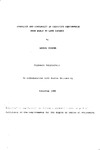STABILITY AND CONTINUITY IN COGNITIVE PERFORMANCE FROM EARLY TO LATE INFANCY
| dc.contributor.author | COOPER, RACHEL | |
| dc.contributor.other | Faculty of Arts, Humanities and Business | en_US |
| dc.date.accessioned | 2013-10-08T09:37:33Z | |
| dc.date.available | 2013-10-08T09:37:33Z | |
| dc.date.issued | 1986 | |
| dc.identifier | NOT AVAILABLE | en_US |
| dc.identifier.uri | http://hdl.handle.net/10026.1/2080 | |
| dc.description.abstract |
This research is concerned with the stability and continuity of cognitive measures throughout the infancy period. A review of the literature showed that standardised infant intelligence tests fail to predict subsequent intellectual performance, and one reason for this may be the dominance of motor based items in the tests, and the relative dearth of measures reflecting cognitive ability. Furthermore, it has been suggested that measures from recently developed procedures, which are considered to reflect learning, memory and discriminative ability in infancy may constitute more useful predictive measures of later intellectual functioning. However, the reliabilities and inter-correlations between these measures have not been systematically studied. At 3 and 5 months of age infants were presented with a variety of tasks, including, visual preferences, visual habituation, concept acquisition, cross-modal integration, operant conditioning and other measures of attention and vocalisation. From these, measures were examined in terms of their across and within sessions reliabilities. Age appropriate tasks were given to the same sample of infants at 9 months of age, and a series of infant intelligence scales and subscales were administered at 18 months. Correlations between the reliable measures across age were examined. The results indicated that a number of measures at 3 months were reliable, and predictive of performance on tasks at 9 months and 18 months. Specifically, the predictive measures from early infancy tended to reflect aspects of fixation duration, and these were related to measures of attention and manual exploration at 9 months, and verbal ability at 18 months. The predicted measures at 9 months were also related to the 18 month verbal measures, indicating some degree of continuity across these ages. The data are tentatively interpreted in terms of a speed of processing model of intelligence and the implications for models of continuity and the implications for future research are discussed. | en_US |
| dc.description.sponsorship | Exeter University | en_US |
| dc.language.iso | en | en_US |
| dc.publisher | University of Plymouth | en_US |
| dc.title | STABILITY AND CONTINUITY IN COGNITIVE PERFORMANCE FROM EARLY TO LATE INFANCY | en_US |
| dc.type | Thesis | |
| plymouth.version | Full version | en_US |
| dc.identifier.doi | http://dx.doi.org/10.24382/4058 |
Files in this item
This item appears in the following Collection(s)
-
01 Research Theses Main Collection
Research Theses Main


